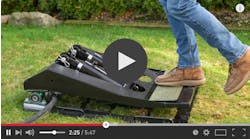Rob Matthes, president of Transducers Direct is a direct kind of guy. "We won't launch 'me too' products. What we design must be driven from fresh ideas that spark new thoughts of where we can apply the technology to further automate processes and bring efficiencies to our customer."
And through that innovative mind-set, Transducers Direct recently launched the TDWLB (Wireless Pressure Transducer).
When asked how the TDWLB differs from similar ones on the market, Matthes' response is, "Simple! There are none!"
"We considered the low power consumption and digital platform of our TD1000 pressure transducer that was released 3 years ago in combination with the rapid growth in wireless technology, and determined it made sense to build on this platform. We utilized the widely accepted Bluethooth wireless connectivity and combined it with our ultra-low power technology and were able to develop the world’s first Bluetooth certified wireless pressure transducer," explained Matthes.
BK: What problems needed to be addressed during the development process?
Matthes: The biggest challenges in developing a wireless pressure transducer are long battery life and a downloadable app, which is easy to navigate. No one wants to replace a battery every month of two. We had to keep the internal signals in the digital world. By doing so and building off the proven digital technology of the TD1000, we are able to obtain 12-18 months of use off a single CR2032 coin cell battery. This, combined with the need to maximize antenna strength and become FCC and Bluetooth certified, presented key design challenges we had to overcome to be successful.
BK: How long did it take from conception to ultimate production?
Matthes:We had a working beta unit and downloadable app from the Apple iTunes store that we did field installation/testing within 6 months. The final product and full production took less than a year.
BK: What effect did cost factors have in changing the final design of the product?
Matthes:From day one, cost and manufacturability were at the top of the list. We invested heavily in tooling to keep component and assembly cost down and to be able to share technology across our different transducer platforms. The Apple iTunes app is an on-going design cost. With each new application/market/OEM we find, new ease-of-use features are created and added to the app.
BK: Who is your target audience and what benefits will they achieve from using this product?
Matthes:The TDWLB is finding its way into a wide range of applications. Medical, food and beverage, water, marine, HVAC/R, industrial gases, and home automation are just a handful of the applications utilizing this product. Customers are now able to monitor their process and set alarms to be proactive and alert them of potential issues before they arise. It also greatly reduces the cost of running cables and installing the product where running wires is not an option.
BK: Do you have any other interesting information you would like to add?
Matthes:The TDWLB allows customers to monitor equipment and processes in ways and places that haven’t been possible before. New applications are finding this sensor every day, and based on this overwhelming success and our customers’ inputs and requests, we see the TDWLB as potentially the first member of a family of wireless sensor products from Transducers Direct. There’s more to come. Stay tuned!










